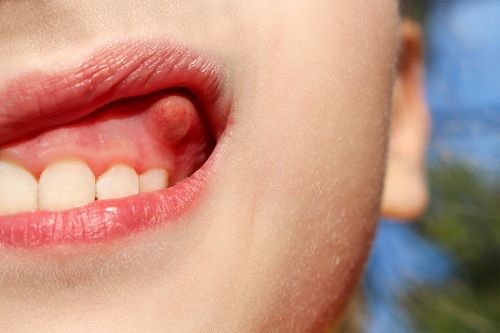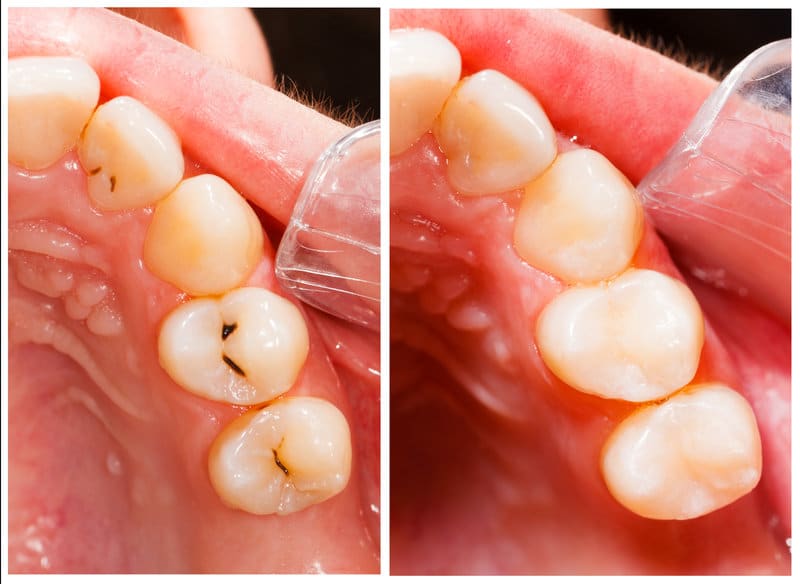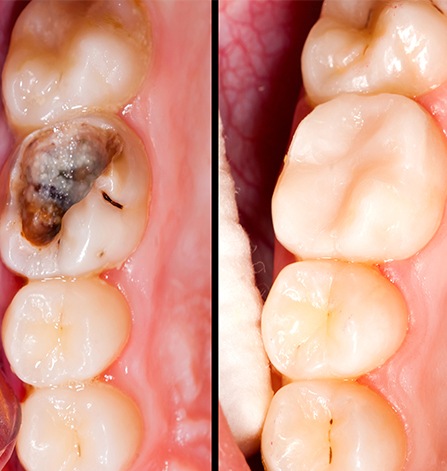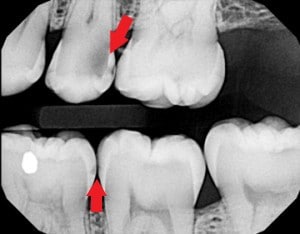Ah, the dreaded mouth pain. When people have sensitivity or pain in their mouth the first thing they think is do I have a cavity? And that’s for good reason.
Tooth decay, or what most people refer to as “cavities,” is one of the most common human ailments. To put in in perspective, the CDC put out a statement that dental cavities are “four times more common than asthma among adolescents aged 14 to 17 years,” and “dental caries affects 9 out of 10 over the age of 20. That’s a lot of affected chompers.
This article will help to answer your burning questions about cavities. We’ll talk about how to tell if you have a cavity, what does a cavity look like, and even what does a cavity feel like. Hopefully, after reading this article, you’ll be even a little wiser to help narrow down a better understanding of your mouth pain.
What is a cavity
Okay, before we dive in to answering how to know if you have a cavity, lets get one thing out of the way. What is a cavity? A cavity is like it sounds. It’s a break or hole in the surface of the tooth. Now that doesn’t sound so bad, but the issue is that it’s more than just a hole.
We’ll discuss it in some detail. Bear with me.
Everyone has a normal amount of bacteria in the mouth. Actually, when you think of the numbers it’s pretty gross. There’s between 1000 to 100,000 cells of bacteria per tooth at any given moment. And do you know what’s worse? This is normal.
The bacteria in our mouth are generally harmless, except for one minor detail. They use the sugars we eat for their metabolism, specifically fermentation. A byproduct of their metabolism is acid. That’s where the problem of cavities comes in.
So here’s what happens. The bacteria cling to the teeth and go about their normal metabolism which produces acid. Although the enamel of the teeth is the hardest material of the human body, it has one major weakness. Acidic liquids.
Acid has the ability to soften enamel which creates a progressively deepening hole—emphasis on progressive. The tunneling deeper into the tooth—That’s the problem.
Once a cavity starts, a person is unable to brush the bacteria out of the cavity. This allows the cavity to progress deeper and deeper into the tooth. Although a cavity begins without even being able to see it, if left long enough, it can crumble an entire tooth.
How to tell if you have a cavity
Now we’ll get to the question you probably want to know, how to know if you have a cavity. I’ll make it simple.
Let’s boil it down to the most common symptoms of cavities first, then later on, we’ll get into discussing what a cavity looks like. The following symptoms are listed as a progression for how to tell if you have a cavity in the early stages versus if you may have a cavity that hasn’t been treated for a long time.
Dark discoloration of the tooth
It’s no surprise people want white teeth. Although most people want white teeth for cosmetic reasons, I think there’s a subliminal reason we want white teeth. It indicates health. A cavity can most easily be identified because it isn’t the same color as the rest of the teeth. The area of a cavity is often severely dark or brown. The color indicates that the enamel is decaying. Healthy enamel is light and hard, and a cavity is dark and soft.
A hole or fracture of the tooth
A cavity begins as a small discoloration, but as it progresses more of the tooth is affected. The tooth becomes soft in the area of the cavity and begins to break away. Parts of the tooth may be missing adjacent to a cavity which has progressed for more than a couple years.
Sensitivity to hot, cold, or sweets

Think of the enamel of the tooth like a helmet. It is an outer shell that protects the pulp and nerve that lie deeper in the tooth. As the decay continues to progress deeper in the tooth, the dentin becomes exposed. The dentin is more porous and can more easily shuttle sensitivity to the nerve. When you have a cavity you may notice that a specific area of your mouth feels sensitivity when drinking something hot or cold liquids or sweet foods.
Pain when biting down
As we talked about, the outer surface of the tooth is like a helmet. When the protective layer is compromised, the sensitive inner layers of the tooth are less shielded from the pressure of normal chewing. If you have a cavity you may have sensitivity when chewing or biting down in situations which otherwise would feel normal.
A bubble or swelling on the gum

How could the gums be involved with a tooth cavity? This is what we call a dental abscess. Here’s how it works.
When dental decay progresses a long time, it eventually tunnels all the way to the dental pulp. Once bacteria reach the pulp, the nerve and blood supply of the tooth are exposed to bacteria, which causes an infection. A tooth infection is called a tooth abscess. A tooth abscess is the body’s way of shuttling the pressure of infection out of the tooth. It usually forms at the end of the root of the tooth and causes swelling of the bone and gum in that area, eventually creating a bubble under the gums.
Bad breath
A cavity creates an uncleanable surface in the tooth in which bacteria can live excessively. It also can create pus from a dental abscess. Both of these conditions can lead to a foul odor. Even if you are attempting to brush your teeth or use mouth wash, you simply cannot access the area that is producing the odor effectively once a cavity has compromised the area.
What does a cavity look like
This section will be pretty straight forward, albeit a little graphic for some. If you have ever wonder what does a cavity look like on a tooth or on an x-ray? This section is for you. I’ll show you images to help you understand.
What a small cavity in the groove of a tooth looks like. We call these “occlusal” decay

What a large cavity looks like once it has progressed. The tooth may have started as a small occlusal cavity but has progressed over a period of years

What a cavity looks like on an x-ray or “radiograph.” The x-rays allow a dentist to see cavities forming in between the teeth known as “interproximal” decay

What does a cavity feel like
Who am I kidding, you’re already an expert. You already know the answer to this question. A cavity can feel like a variety of sensations depending on progression.
In the early stages of a cavity, you most likely will not notice anything. A small cavity typically will feel normal. But don’t let that deceive you.
When a cavity is small it often has little effect on your daily life. However, that’s the most concerning point to make. It’s best to treat a cavity before it reaches a point of severe symptoms for two reasons:
You will not lose as much tooth structure
Although a dental treatment is excellent to restore teeth, it’s always best to maintain as much of your natural tooth structure as possible. As a cavity progresses, it will result in a larger dental restoration being needed. This isn’t the end of the world, but later in life, if that large restoration needs to be replaced, it could be the difference between replacing a small simple filling versus a more complex dental treatment being required.
Early prevention of cavities is more predictable and cost-effective
This one makes sense. If you take care of a cavity when it’s small, you’re probably going to have an easier experience. If that same cavity progresses a few months or years too late, it could be a much more complex amount of dental work needed to fix the same problem.
When a cavity progresses longer than 6-12 months you will begin to feel symptoms
Keep an eye on your teeth. You may notice a tooth just seems different than the rest throughout your daily routine. Common symptoms of a moderately progressing cavity are temperature sensitivity or biting sensitivity when chewing. Those are usually the first signs.
If a cavity progresses for a very long time, that’s when it can create pain or even a dental emergency. At that point, the cavity feels pain, even when unprovoked. Think of it in terms of laying in bed at night and having a throbbing sensation. That’s an indication of a deep cavity. At that point, the cavity has progressed deep within the tooth all the way to the nerve.
What to do If I think I have a Cavity
That’s simple. If you have minor discomfort, give it a few days with over the counter pain medication, and see if it gets better. Don’t be alarmed. It might be just a passing sensitivity that sometimes occurs. However, if minor discomfort lingers for more than a week or two, you should contact your dentist to have it evaluated. And what if you have severe throbbing pain? Contact your dentist immediately. They often can prescribe an antibiotic to help reduce the infection and will plan to treat the area to limit the time you are in discomfort.


